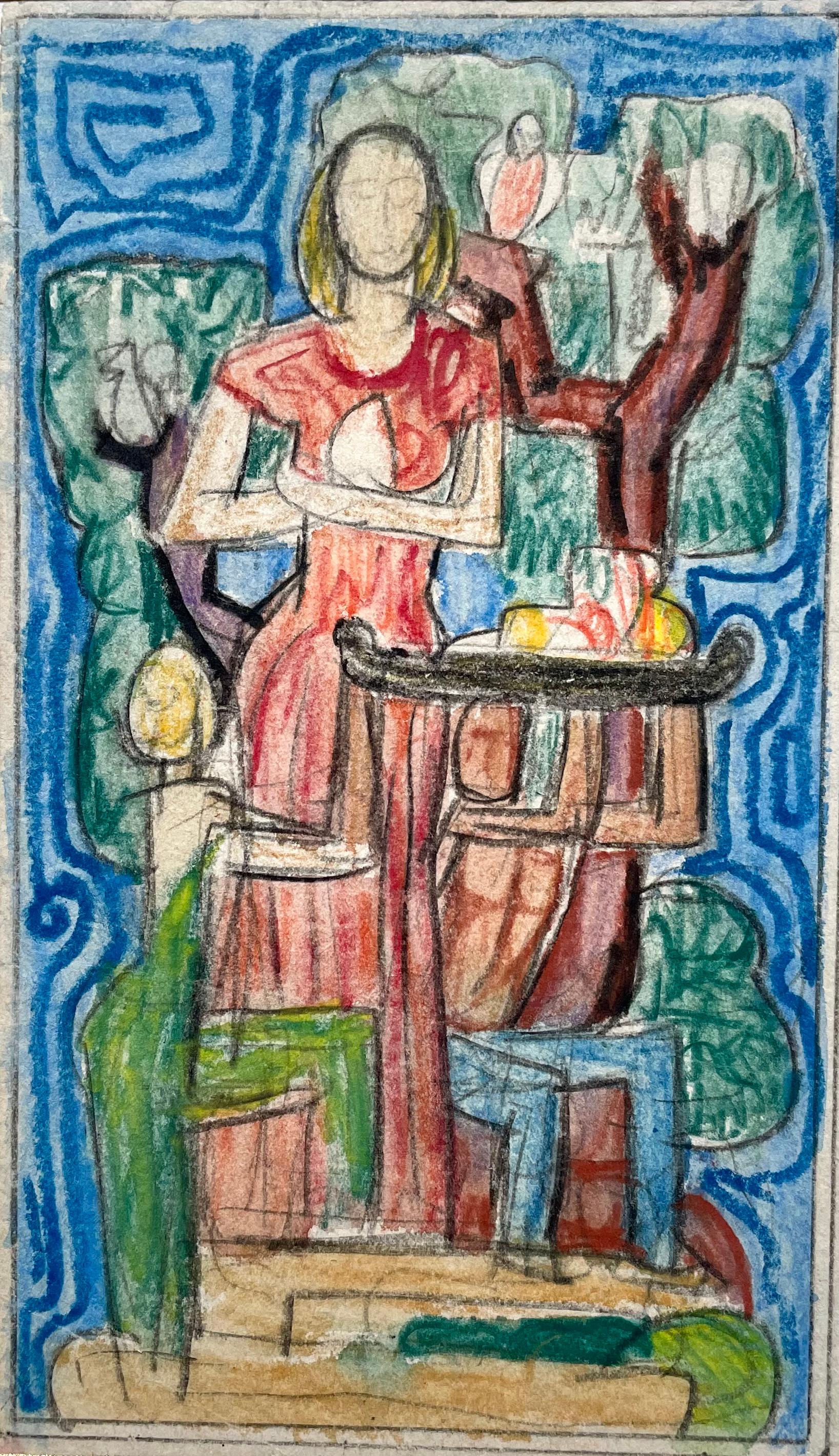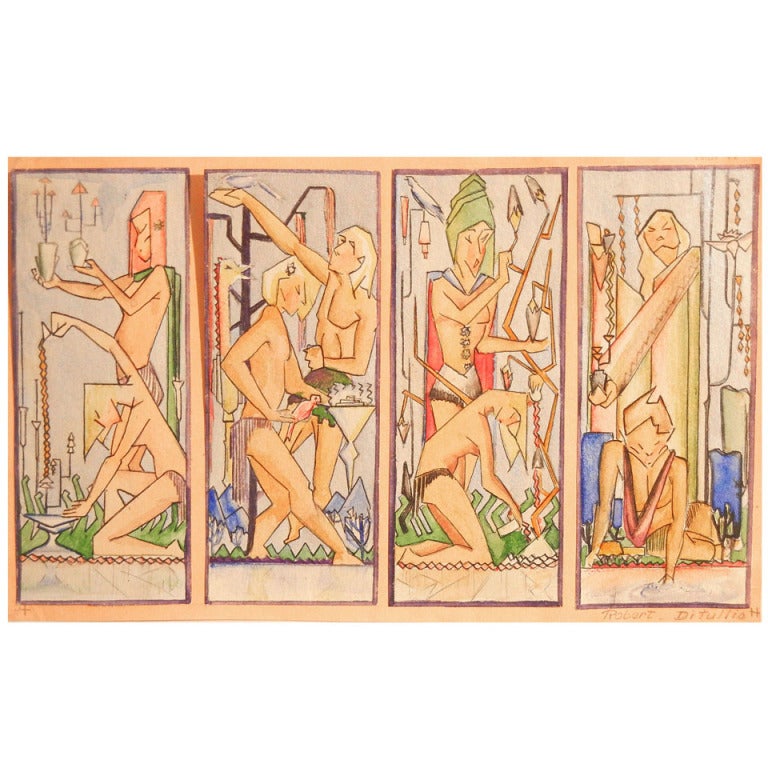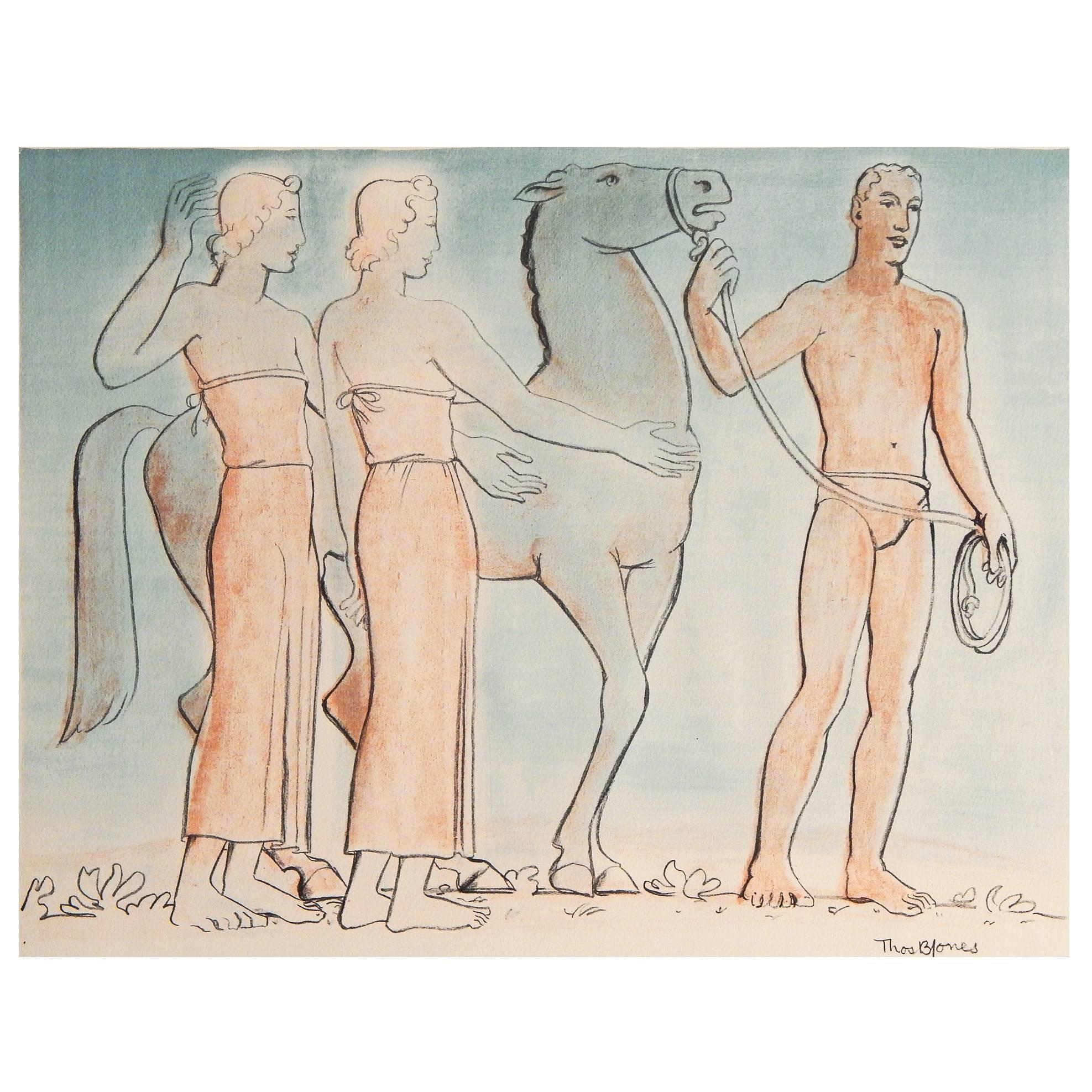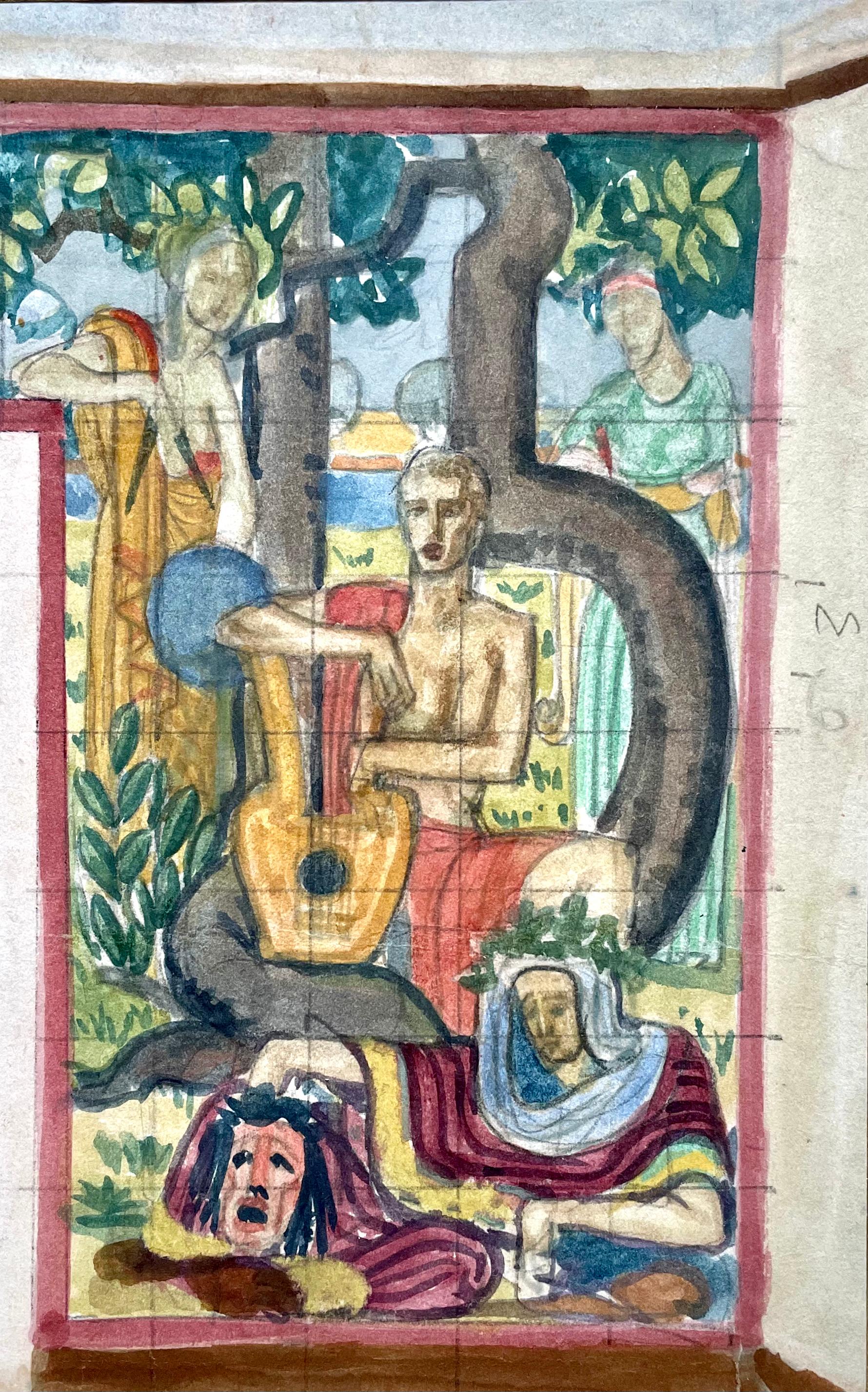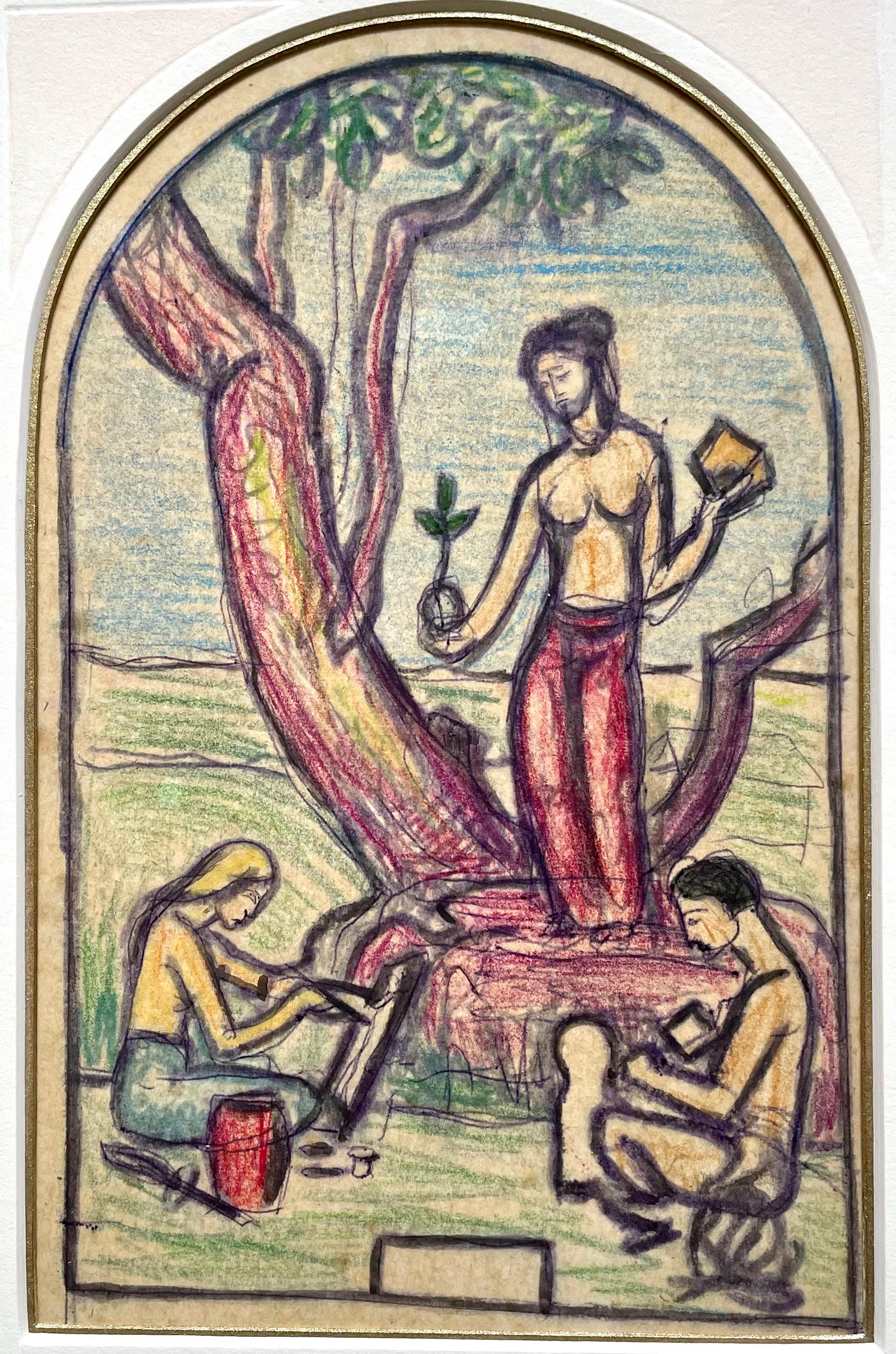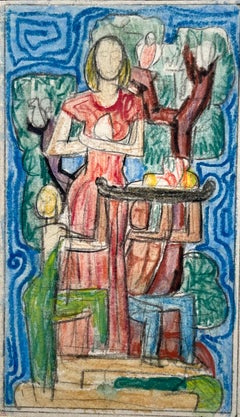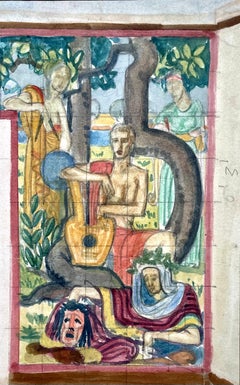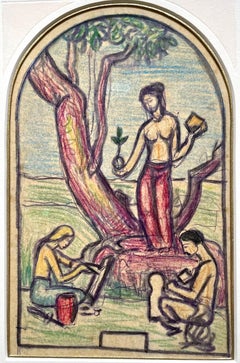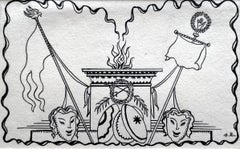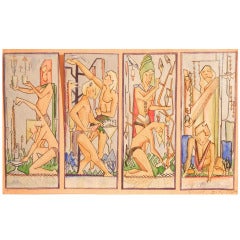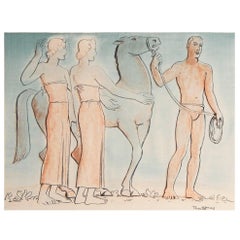Items Similar to Gilbert Ledward - 1930s Watercolour Design for a Decorative Sculptural Frieze
Want more images or videos?
Request additional images or videos from the seller
1 of 10
Gilbert LedwardGilbert Ledward - 1930s Watercolour Design for a Decorative Sculptural Frieze1933
1933
$2,724.12
£2,000
€2,344.19
CA$3,812.45
A$4,180.05
CHF 2,182.79
MX$50,301.67
NOK 27,510.59
SEK 25,867.03
DKK 17,506.77
About the Item
GILBERT LEDWARD, RA, PRBS
(1888-1960)
Tennis, Golf, Shooting, Ice-Skating, Dreaming – Proposed Design for Decorative Frieze in the Italian Drawing Room at Eltham Palace, commissioned by Stephen Courtauld
Signed and dated July 9th 1933
Watercolour and pencil
12.5 by 49.5 cm., 5 by 19 ½ in.
(frame size 36 by 67 cm., 14 ¼ by 26 ¼ in.)
Exhibited:
The artist’s daughter;
London, The Fine Art Society, A Centenary Tribute, Feb 1988, no. 43.
Gilbert Ledward was born in London. He was educated at St Mark’s College, Chelsea. In 1905 he entered the Royal College of Art to study sculpture under Edouard Lanteri and in 1910 he entered the Royal Academy Schools. In 1913 he won the Prix de Rome for sculpture, the Royal Academy’s travelling award and gold medal, which allowed him to travel in Italy until the outbreak of the Wold War I. During the war he served as a lieutenant in the Royal Garrison Artillery and was appointed as an official war artist in 1918.
Following the war he was largely occupied as a sculptor of war memorials including the Guards Division memorial in St James’s Park and the Household Division’s memorial in Horse Guards Parade. In 1934, supported by Eric Gill and Edwin Lutyens, he established a company called Sculptured Memorials and Headstones, which promoted better design of memorials in English churchyards. His war memorials after World War II include one in Westminster Abbey to the Submarine Service, Commandos and Airborne Forces.
Ledward was Professor of Sculpture at the Royal College of Art (1927-1929) and in 1937 was elected at Royal Academician. He became President of the Royal Society of British Sculptors and a trustee of the Royal Academy.
The present work is a design for an intended decorative frieze for the Italian Drawing Room of Eltham Palace. In 1935 the remains of the medieval royal palace of Eltham was rescued from decay by Stephen and Virginia Courtald who built an ultra modern Art Deco house to adjoin the existing Great Hall. They employed the architects John Seeley and Paul Edward Paget and the fashionable Mayfair interior designer the Marchese Peter Malacrida to design the strikingly glamorous 1930s interiors of the new house. The dramatic entrance hall was created by the Swedish designer Rolf Engstromer. In addition to the frieze design for the drawing room Ledward executed a series of sculptural reliefs representing the sporting and leisure interests of the Courtaulds.
- Creator:Gilbert Ledward (1888 - 1960)
- Creation Year:1933
- Dimensions:Height: 12.5 in (31.75 cm)Width: 49.5 in (125.73 cm)
- Medium:
- Movement & Style:
- Period:
- Condition:
- Gallery Location:London, GB
- Reference Number:Seller: 15271stDibs: LU1028312409982
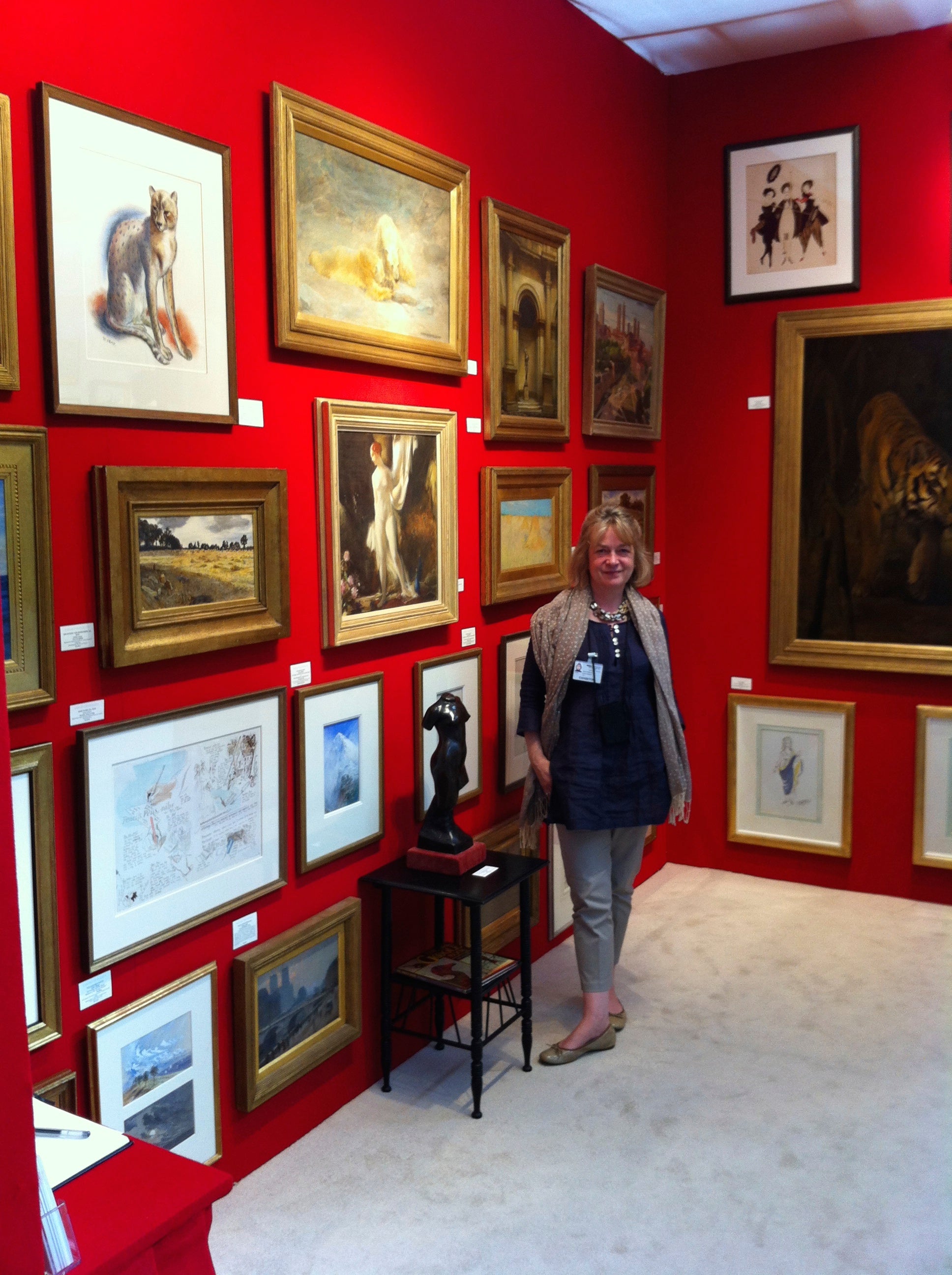
About the Seller
4.9
Vetted Professional Seller
Every seller passes strict standards for authenticity and reliability
Established in 2004
1stDibs seller since 2018
62 sales on 1stDibs
Typical response time: 4 hours
- ShippingRetrieving quote...Shipping from: Banbury, United Kingdom
- Return Policy
Authenticity Guarantee
In the unlikely event there’s an issue with an item’s authenticity, contact us within 1 year for a full refund. DetailsMoney-Back Guarantee
If your item is not as described, is damaged in transit, or does not arrive, contact us within 7 days for a full refund. Details24-Hour Cancellation
You have a 24-hour grace period in which to reconsider your purchase, with no questions asked.Vetted Professional Sellers
Our world-class sellers must adhere to strict standards for service and quality, maintaining the integrity of our listings.Price-Match Guarantee
If you find that a seller listed the same item for a lower price elsewhere, we’ll match it.Trusted Global Delivery
Our best-in-class carrier network provides specialized shipping options worldwide, including custom delivery.More From This Seller
View AllPlenty - 1930s British Art Deco design for a Mural by Harry Carleton Attwood
Located in London, GB
HARRY CARLETON ATTWOOD
(1907-1985)
Plenty - Design for Eltham Palace
Chalks
Framed
20.5 by 12 cm., 8 by 4 ¾ in.
(frame size 39.5 by 31.5 cm., 15 ½ by 12 ½ in.)
Attwood was born i...
Category
1930s Art Deco Figurative Drawings and Watercolors
Materials
Chalk
Orpheus - Art Deco British watercolour design for a mural by H C Attwood
Located in London, GB
HARRY CARLETON ATTWOOD
(1907-1985)
Orpheus - Design for Eltham Palace
Watercolour, squared for transfer
Framed
22.5 by 14 cm., 9 by 5 ½ in.
(frame size 39.5 by 31.5 cm., 15 ½ by 1...
Category
1930s Art Deco Figurative Drawings and Watercolors
Materials
Watercolor
The Model - 1930s mural design for Eltham Palace by Harry Carleton Attwood
Located in London, GB
HARRY CARLETON ATTWOOD
(1907-1985)
The Model - Design for Eltham Palace
Coloured chalks, arched top
Framed
21 by 13 cm., 8 ¼ by 5 in.
(frame size 39.5 by 31.5 cm., 15 ½ by 12 ½ in...
Category
1930s Art Deco Figurative Drawings and Watercolors
Materials
Chalk
Albert Rutherston - 1920s British Illustration for Cymberline
Located in London, GB
ALBERT RUTHERSTON, RWS
(1881-1953)
Tailpiece – Illustration for The Tragedie of Cymberline
Signed with initials l.r. AR; also signed with initials and inscribed beneath the mount: Tailpiece for end/of play {Cymberline}/No Reduction unless/”lay out”should make/necessary AR
Pen and ink
Unframed
6 by 10 cm., 2 ½ by 4 in.
(mount size 36.5 by 25.5 cm., 14 ½ by 10 in.)
Provenance:
Estate of the artist
Exhibited:
London, Sally Hunter Fine Art, Albert Rutherston, Drawings, Theatre Designs and other Treasures, 2016, no.66
The present work was illustrated in Cymbeline, published by Ernest Benn in 1923. The series was a collaboration between Rutherston and Harley Granville-Barker following on from their work together 11 years earlier at the Savoy Theatre and celebrating the quatercentenary of the Shakespeare Folio edition.
Born Albert Daniel Rothenstein, he was the youngest of the six children of Moritz and Bertha Rothenstein, German-Jewish immigrants who had settled in Bradford, Yorkshire in the 1860s. He and his siblings proved to be a hugely talented and artistic family, his elder brother became Sir William Rotherstein (1872-1945), the artist and director of the Royal College of Art; two of his other siblings, Charles Rutherston and Emily Hesslein, both accumulated major modern British and French art collections and his nephew Sir John Rothenstein was direct of the Tate Gallery.
He was educated at Bradford Grammar School before moving to London in 1898 to study at the Slade School of Art where he became close friends with Augustus John and William Orpen. He met Walter Sickert during a painting holiday in France in 1900 and by introducing Sickert to Spencer Gove became instrumental in the beginning of the Camden Town Group. He was one of Sickert’s most frequent companions and was one of the original members of the Fitzroy Street Group. Rutherston had a sociable and attractive personality, he frequently travelled abroad with other artists including Max Beerbohm, Spencer Gore, Walter Russell and Edna Clarke...
Category
1920s Realist Landscape Drawings and Watercolors
Materials
Ink
Resting - 1930s British design for a mural by Harry Carleton Attwood
Located in London, GB
HARRY CARLETON ATTWOOD
(1907-1985)
Resting - Design for Eltham Palace
Watercolour over traces of pencil
Framed
20 by 14 cm., 8 by 5 ½ in.
(frame size 39.5 by 31.5 cm., 15 ½ by 12 ...
Category
1930s Art Deco Figurative Drawings and Watercolors
Materials
Watercolor
Fruit Gatherers - 1930s Design for a mural by Harry Carleton Attwood
Located in London, GB
HARRY CARLETON ATTWOOD
(1907-1985)
Fruit Gatherers - Design for Eltham Palace
Chalks
Framed
23 by 13 cm., 9 by 5 in.
(frame size 39.5 by 31.5 cm., 15 ½ by 12 ½ in.)
Attwood was b...
Category
1930s Art Deco Figurative Drawings and Watercolors
Materials
Chalk
You May Also Like
Extraordinary Study for Art Deco Mural/Screen by DiTullio
By Frank Lloyd Wright
Located in Philadelphia, PA
Clearly influenced by the decorative motifs of Frank Lloyd Wright, Rennie Mackintosh and the Secessionists, this remarkable study for a set of four murals (or four panels of a foldin...
Category
Early 20th Century American Art Deco Paintings
Materials
Pen, Pencil, Watercolor, Gouache, Paper
"Modern Greek Frieze with Horse, " Extremely Rare WPA-Period Watercolor, 1930s
Located in Philadelphia, PA
Beautifully composed and subtly colored in hues of pale, pale blue and rusty red, this frieze-like composition features two female figures in Classical Greek robes...
Category
Vintage 1930s American Art Deco Drawings
Materials
Paper
Art Deco Polo Mural Study Signed by Wheeler Williams
By Wheeler Williams
Located in New York, NY
Wheeler Williams (American, 1897-1972)
Untitled Study, 1944 (Polo Players)
Pencil on paper
15 1/2 x 19 1/4 in.
Signed lower right: Wheeler Williams, 1944
Artist studio label verso
Inscribed on mat:
Drawings for Proposed Murals: Polo Room, Hotel Plaza....
A native of Chicago, Wheeler Williams is known for his allegorical, narrative work including "Tablets to Pioneers" on the Michigan Avenue bridge in Chicago, and "Settlers of the Seaboard" in Fairmount Park in Philadelphia.
He graduated with honors from Yale University in 1919 and earned a Master of Architecture degree from Harvard in 1922. He studied at the Art Institute of Chicago with sculptor Albin Polasek...
Category
1940s Art Deco Figurative Drawings and Watercolors
Materials
Paper, Pencil
Henri Rapin, Gouache on Paper "Fructidor", 1924-1928
Located in Saint Amans des cots, FR
This gouache is a museal and historical piece. Gouache and charcoal on paper stuck on panel by Henri Rapin, France, 1924-1928. "Fructidor". With frame: 80x114x3 cm - 31.5x44.9x1.2, w...
Category
1920s Art Deco Figurative Drawings and Watercolors
Materials
Paper, Gouache
Caerulea - British Art Deco c1935 watercolour and ink figurative painting
Located in Hagley, England
This beautiful British Art Deco 1930's water colour and ink painting on paper is by well respected artist Averil Mary Burleigh. Painted circa 1935 the composition is of three female figures with flowing robes and head dresses with slender tree trunks beyond them and vivid blue of the sky meeting the sea. (Caerula pertains to the colour of the sky and sea). They are playing between them with two balls or globes. A beautiful painting full of fun and movement and that amazing blue.
Signed lower left, and inscribed on a label verso.
Provenance: Surrey estate.
Condition. Water colour and ink on paper. Image size is 24 inches by 16 inches and in excellent condition.
Frame. Housed in a gilt frame. Framed size is 30 inches by 22 inches and in good condition.
Averil Mary Burleigh born Averil Mary Dell (1883 – 1949) was a British artist and painter. Based in Sussex, Burleigh was known for painting in egg tempera with the subject usually involving a central figure. Her husband and daughter also painted but she is the best regarded of the three. Burleigh was born in 1883 in Hassocks in West Sussex and went on to study at the Brighton School of Art. She married the painter Charles Burleigh and they lived and worked together as artists in Hove and Sussex. They designed a house with a large sun-lit top floor studio. Their daughter Veronica, who would also become a notable artist, was born there in 1909. The family never became rich from their works, and often relied on Burleigh's flair for buying and selling shares. In 1911 Burleigh illustrated a book of John Keats' poetry and went on to illustrate plays by Shakespeare. In 1913 she was featured in Studio magazine. In 1927 Burleigh illustrated Thistledown by Leolyn Louise Everett. From 1939 she was a member of the Royal Society of Painters in Watercolours. Burleigh became very ill in the 1940s, dying in 1949. Shortly before she died, Burleigh was elected an associate of the Royal Watercolour Society. Burleigh specialised in tempera painting, although she also worked in chalk and watercolour. Her works tend to have a bright colour palette with contrasting colours to lead the eye around the picture. A sharp luminosity and strong sense of design govern Burleigh's tempera and watercolour paintings. Frequently, her works portray decorative renaissance subjects, usually dominated by a female figure who is regularly modelled on her daughter, Veronica Burleigh...
Category
1930s Art Deco Figurative Drawings and Watercolors
Materials
Ink, Watercolor
Averil BurleighCaerulea - British Art Deco c1935 watercolour and ink figurative painting, Circa 1935
$13,074 Sale Price
20% Off
Plaster Sculpture Relief Art Deco Plaque WPA Artist Peace Swords to Ploughshares
By George Aarons
Located in Surfside, FL
Size includes wood mounting.
George Aarons (born Gregory Podubisky, in St. Petersburg, Russia, 1896 - died in Gloucester, Massachusetts 1980) was a distinguished sculptor who lived ...
Category
20th Century Art Deco Figurative Sculptures
Materials
Plaster, Wood
More Ways To Browse
Edward Paul
Vintage Submarines
Italian Frieze
Horse Guards
Lolly Pop
Marshall Fredericks
Martin Eichinger
Matteo Mauro
Maurice Duchin
Mr Imagination
Nude Fun
Nureyev Bronze
Outdoor Pop Art Sculptures
Picasso Terracotta Tile
Pop Art Sculpture Figures
Rachel Ann Stevenson
Richard Macdonald Allonge
Richard Macdonald Elena
